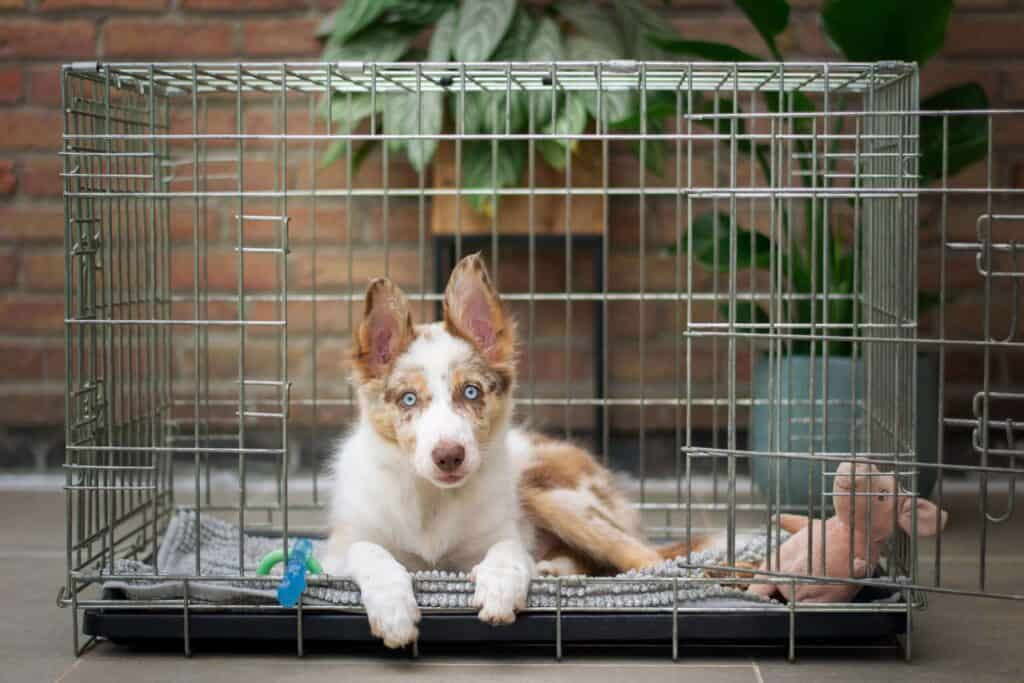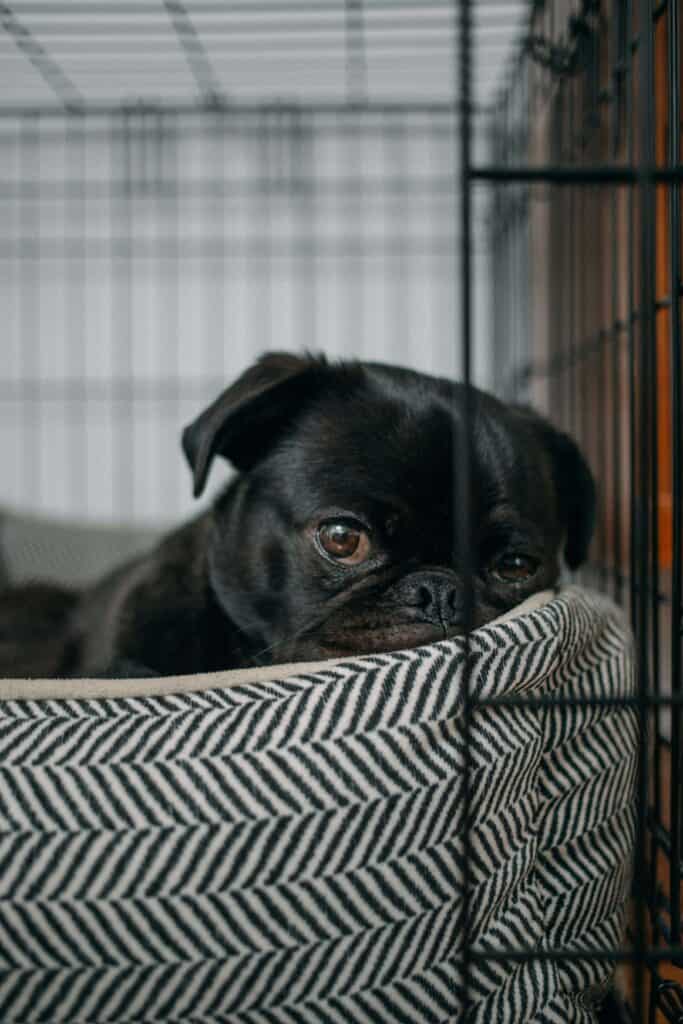Pet Lovers
04/23/2018
When your Dog loses his Best Friend
There was the most beautiful husky at the Stony Point mall the other day…. I asked her owner if I…
Monday – Friday
7:00 am – 7:00 pm
Saturday
7:00 am – 6:00 pm
Sunday
9:00 am – 6:00 pm
Monday – Friday
7:00 am – 7:00 pm
Saturday
7:00 am – 6:00 pm
Sunday
9:00 am – 6:00 pm
Crate training your puppy can be frustrating and stressful for you and your new furry friend. If your puppy has been excessively crying, whining, or barking in their crate, you may be questioning whether crate training your puppy is worth it or whether you’re doing it right at all. A factor that may help in understanding these behaviors lies in the psychology of dog toys and other comforting elements in a crate.
Rest assured that you’re not alone; puppy crate training is not easy. However, crate training is an essential tool that helps your puppy learn boundaries, potty training, and provides a safe place to rest that is all their own. It’s also important to consider what dogs feel when we leave them in the crate.
Let’s chat about why crate training helps puppies feel more secure and tips on dealing with a crying puppy while training, including addressing issues like a dog shaking in crate.

Have you ever noticed how a pup likes to seek out smaller, secure areas to lie down? Does your adult dog sometimes prefer to nap under your desk, other furniture, or maybe burrow under blankets? These actions could all be interpreted as instinctively seeking out a den. A dog’s desire to make a den is a very strong instinct. A den was a place of comfort and safety for our dogs’ ancestors. It was a place to hide from predators. More often, a den was dug by a pregnant female dog in order to have a safe place to have her pups and shelter them while they are growing. So, the very first exposure to a puppy’s new world was in a warm, secure, cozy, little den with Mom’s protection.
Isn’t it logical, therefore, that a puppy instinctively seeks out a warm and cozy cubby? A den, so to speak, to escape to and unwind… or rather, a comfy little crate? Providing your crying puppy a crate could be one of the nicest things you ever do for her. It’s a brand new world for these tiny pups… and a little scary for sure. There are many benefits of crate training a puppy. As she grows and becomes more confident and secure, she will tend to spend more time outside the crate, rather than inside, but will always be aware that when she’s tired, or the world feels a little crazy (the holidays, for example), she has a comforting place to retreat to. Dogs actually seek the closure a crate provides, as it helps them unload or slow down their sensory responses.
So, she’s in her crate, and all is right with the world…. except that she is still whimpering. How can you know why she’s whining? Here are some of the most common reasons:
Ensure your puppy is not crying in her crate at night because she has to go potty. In fact, it’s a good idea to take her outside for a potty walk right before she goes in her crate and immediately when she comes out. Make sure she eliminates completely.
This way, you know if she’s crying, it’s not because she needs to go outside to potty. As she becomes used to the routine, she will begin to understand when and where to relieve herself. Another reason potty training a puppy with a crate works is because they naturally prefer to potty away from where they are sleeping and eating.
Sometimes a puppy won’t stop crying in their crate because they just want to be with their owner. Making sure that you encourage your puppy to feel okay by herself in her crate is super important and is one of the best things you can do when crate training a puppy.
Engaging in a fun treat game, practicing tricks, or a game of fetch before putting your puppy in its crate will help to drain her energy so that she will be more inclined to relax and sleep when put in her crate. Young puppies should be sleeping about 18 hours a day, so crating a puppy for nap times each day is an easy way to ensure your puppy is getting enough sleep. As they mature, the amount of sleep they require will decrease.
Too often, people look at crate training a puppy as the equivalent of jail time for their dog. They are appalled at the idea of confining their dog to a cage. When properly introduced and used correctly, a crate is far from the prison we imagine. Here are some tips:
One of the most common mistakes new pet owners make is to give their puppies too much attention or to let them out once they start whining.
It is important to allow a puppy crying in their crate to self-soothe a bit to ensure they do not whine and cry every time they are confined to receive your attention. If you respond too much to a crying puppy in their crate, they will learn to train you!
You can ignore your dog’s whining or crying behaviors in their crate for up to 10 – 15 minutes. After that amount of time, it’s best to take a step back and work on other crate training methods, like familiarizing them with their crate or exercising them beforehand.

Take the time to acclimate your puppy to the crate slowly. Dogs are naturally curious creatures, and it may take longer than you think to understand that their crate is a comfortable and happy space rather than a scary one.
First, keep the crate open and let your pup explore it at their own pace. Use dog treats to reward them as they approach the crate and step inside. Next, invite them inside the kennel with a toy or treat and close the door. Close the door slowly and do not keep the door closed more than a few moments, otherwise your might spook your puppy from entering the crate next time.
After you’ve tried closing the door a few times, next, crate up your puppy and step away for two or three minutes. Then, open up the crate, and reward your puppy with a treat and a potty break. This will help them get used to the routine you want to build without causing unnecessary anxiety.
Over time, you should increase the increments of time that you are away from the kennel until your puppy can be comfortable in their crate for a few hours.
Don’t underestimate the power of playtime. Puppies have a lot of energy and need to get it out with regular exercise. Once you’ve worked out that pent-up energy with a play session or walk, you’ll be surprised at how willing your new dog is to nap in their crate.
If your puppy is especially high-energy, as many breeds tend to be, you can try adding interactive toys to your puppy’s crate to ensure that they won’t be bored even after they’ve rested from playtime.

If you want a puppy to associate their crate as a good place, you can reward them with a treat every time she enters her crate. Do small crate training sessions of having your puppy go inside the crate, reward (with a treat or toy), shut the door, and repeat several times just to make her feel good about going in and out of her crate. It is also good mental work to do this fun game and a great way to crate train a puppy!
To maintain that pleasant respite for your dog, there are a few rules to keep in mind:
A dog will naturally outgrow their instinct and desire for a den, but the pleasure of having her own happy place will always be a part of her… even as a mature dog. Let us know if we can help! We offer some of the best dog training in Richmond, VA!